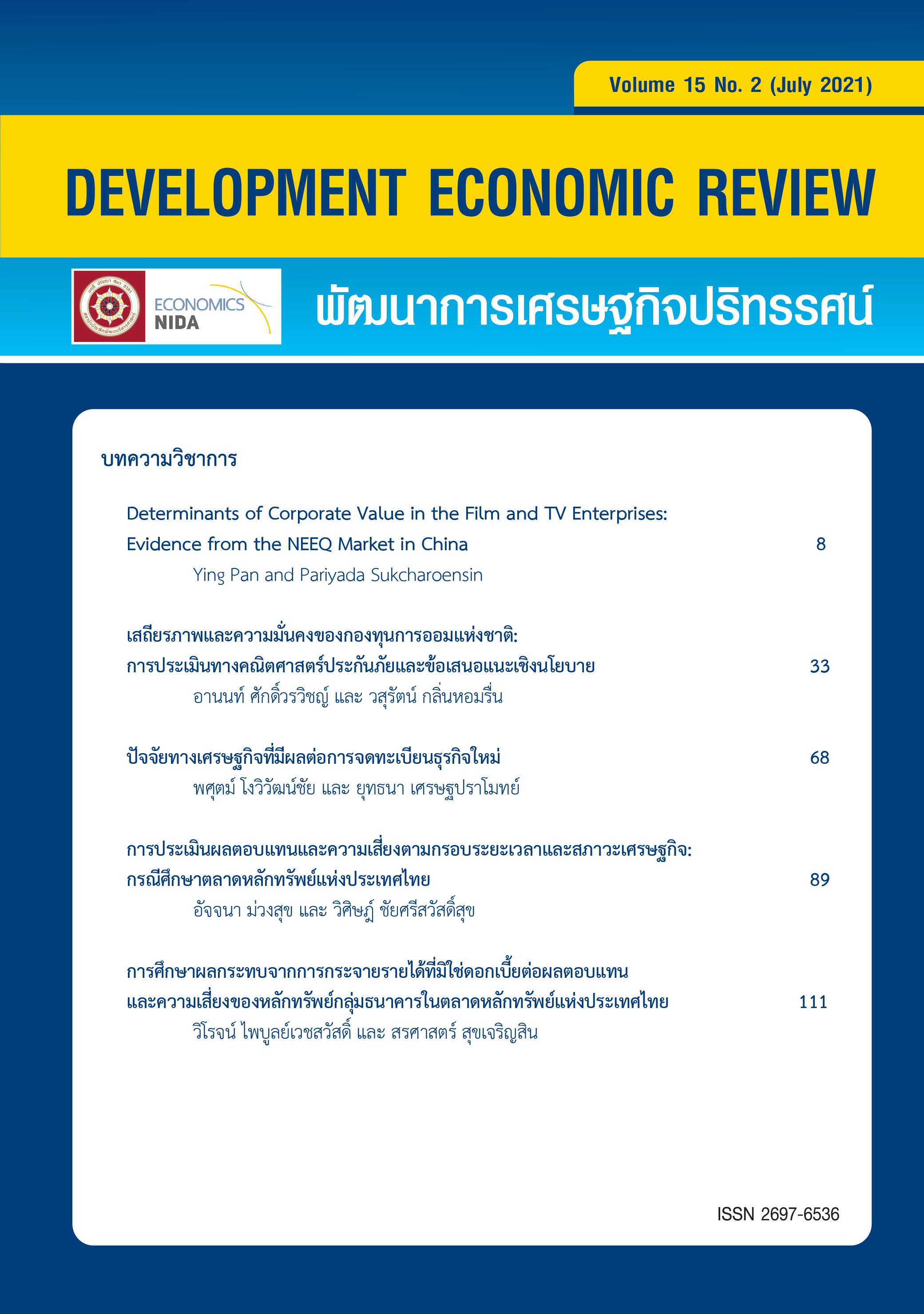Effects of Non-Interest Income Diversification on Stock Return and Risk of Thai Commercial Bank in the Stock Exchange of Thailand
Keywords:
Non-interest revenue diversification, Risk-adjusted rate of return, Thai commercial banksAbstract
The purpose of this study is to expand the empirical study results on the impact of non-interest income distribution to the return and risk of banks of a group of 10 commercial banks that are listed on the Stock Exchange of Thailand over the period of 19 years from 1997-2015. From the empirical study, it is found that the bank's adjusted non-interest revenues have increasing pattern and there is a positive relationship between non-interest revenues and profitability. In addition, it is found that the increasing trend of the proportional income from commission fees and the income from various investments lead to a reduction in the risk-adjusted rate of return of the banks. Especially, when the commercial banks adjust the distribution index by depending too much on non-interest revenues (over-diversification) will negatively affect the risk-adjusted rate of return.
References
Baele, L., De Jonghe, O., & Vander Vennet, R. (2007). Does the stock market value bank
diversification?. Journal of Banking and Finance, 31, 1999–2023.
Berger, A. N., Hasan, I., & Zhou, M. (2010). The effects of focus versus diversification on bank performance: evidence from Chinese banks. Journal of Banking and Finance, 34, 1417–1435.
Chantapong, S. (2005). Comparative study of domestic and foreign bank performance in Thailand: the regression analysis. Economic Change and Restructuring, 38, 63–83.
Chiorazzo, V., Milani, C., & Salvini, F. (2008). Income diversification and bank performance:
evidence from Italian Banks. Journal of Financial Services Research, 33, 181–203.
Demirgüç-Kunt, A., & Huizinga, H., (2004). Market discipline and deposit insurance. Journal of Monetary Economics, 51 (2), 375–399.
Demirgüç-Kunt, A., & Huizinga, H. (2010). Bank activity and funding strategies: the impact on risk and returns. Journal of Financial Economics, 98 (3), 626–650.
DeYoung, R., & Roland, K. P. (2001). Product mix and earnings volatility at commercial banks: evidence from a degree of leverage model. Journal of Financial Intermediation, 10, 54–84.
Gochoco-Bautista, S., Oh, S. N., Rhee, S. G. (2000). In the eye of the Asian financial maelstrom: banking sector reforms in the Asia-Pacific region. Asian Development Bank, 1, 50–106.
Haq, M., Faff, R., Seth, R., & Mohanty, S. (2014). Disciplinary Tools and Bank Risk Exposure. Pacific-Basin Finance Journal, 26, 37–64.
Jensen, M., & Meckling, W. (1976). Theory of the firm: managerial behavior, agency costs, and ownership structure. Journal of Financial Economics, 3, 305–360.
Klein, P. G., & Saidenberg, M. R. (1997). Diversification, organization and efficiency: Evidence from bank holding companies. mimeo.
Laowattanabhongsea, S., & Sukcharoensin S. (2018). Bank Competition and Economic Growth: A Cross-Country Investigation. Southeast Asian Journal of Economics, 6 (1), 1-21.
Lee, C. C., Hsieh, M. F., & Chang, C. H. (2014). The relationship between revenue diversification and bank performance: Do financial structures and financial reforms matter.? Japan and the World Economy, 29, 18–35.
Lee, C. C., Yang, S. J., & Chang, C. H. (2014). Non-interest income, profitability, and risk in banking industry: A cross-country analysis. The North American Journal of Economics and Finance, 27, 48–67.
Lepetit, L., Nys, E., Rous, P., & Tarazi, A. (2008). Bank income structure and risk: An empirical analysis of European banks. Journal of Banking & Finance, 32, 1452–1467.
Lin, J. R., Chung, H., Hsieh, M. H., & Wu, S. (2012). The determinants of interest margins and their effect on bank diversification: Evidence from Asian banks. Journal of Financial Stability, 8 (2), 96-106.
Meslier, C., Tacneng, R., & Tarazi, A. (2014). Is bank income diversification beneficial? Evidence from an emerging economy. Journal of International Financial Market Institutions and Money, 31(1), 97–126.
Nguyen, M., Skully, M., & Perera, S. (2012). Bank market power and revenue diversification:
evidence from selected ASEAN countries. Journal of Asian Economics, 23(6), 688-700.
Pennathur, A. K., Subrahmanyam, V., & Vishwasrao, S. (2012). Income diversification and risk: does ownership matter? An empirical examination of Indian banks. Journal of Banking and Finance, 36, 2203–2215.
Rajan, R., Servaes, H., & Zingales, L. (2000). The cost of diversity: the diversification discount and inefficient investment. Journal of Finance, 55, 35–80.
Sanya, S., & Wolfe, S. (2011). Can banks in emerging economies benefit from revenue diversification?. Journal of Financial Services Research, 40, 79–101.
Sawada, M. (2013). How does the stock market value bank diversification? Empirical evidence from Japanese banks. Pacific-Basin Finance Journal, 25, 40–61.
Stein, J. C. (1997). Internal capital markets and the competition for corporate resources. Journal of Finance, 52, 111–133.
Senesombath, V. & Sukcharoensin, S. (2020). Evaluating the Operating Efficiency of Commercial Banking Sector in Lao PDR, Journal of Global Business Review 22 (2), 23-39.
Stein, J. C. (2002). Information production and capital allocation: decentralized vs. hierarchical firms. Journal of Finance, 57, 1891–1921.
Stiroh, K. J. (2004). Diversification in banking: Is noninterest income the answer?. Journal of Money, Credit, and Banking, 36 (5), 853–882.
Stiroh, K. J., & Rumble, A. (2006). The dark side of diversification: the case of US financial holding companies. Journal Banking Finance, 30, 2131–2161.
Sufian, F., & Habibullah, M. S. (2010). Developments in the efficiency of the Thailand banking sector: A DEA approach. International Journal of Development Issues, 9(3), 226-245.

Downloads
Published
Issue
Section
License
Copyright to published manuscripts becomes the property of the Graduate School of Development Economics, National Institute of Development Administration. Reproduction of all or part of a Development Economic Review (DER) article by anyone, excluding author(s), is prohibited, unless receiving our permission.
Disclaimer: Opinions expressed in articles published in this journal are those of the author (s) and do nto necessarily represent opinions of the Graduate School of Development Economics, National Institute of Development Administration. Trade and proprietary names are only for identification and not constitute our endorsement.

